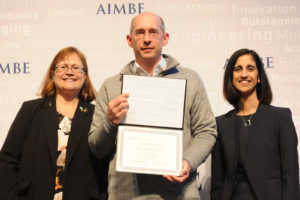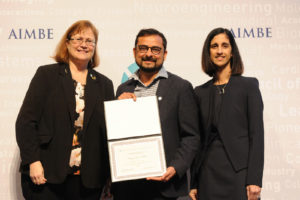University of Utah biomedical engineering professor Sarang Joshi and electrical and computer engineering chair and professor and biomedical engineering adjunct professor, Florian Solzbacher, have each been named to the College of Fellows of the American Institute for Medical and Biological Engineering.
Election to the AIMBE College of Fellows is among the highest professional distinctions accorded to a medical and biological engineer. The College of Fellows is comprised of the top two percent of medical and biological engineers. College membership honors those who have made outstanding contributions to “engineering and medicine research, practice, or education” and to “the pioneering of new and developing fields of technology, making major advancements in traditional fields of medical and biological engineering, or developing/implementing innovative approaches to bioengineering education.”
A formal induction ceremony was held during the AIMBE Annual Meeting at the National Academy of Sciences in Washington, DC, on March 25. Joshi and Solzbacher were inducted along with 156 colleagues who make up the AIMBE College of Fellows Class of 2019.

Solzbacher received a bachelor’s from Saarland University in Saarbrücken, Germany, and a master’s from the Technical University of Berlin, both in electrical engineering. He earned a doctorate in electrical/bio engineering from Ilmenau University of Technology in Germany. He joined the University of Utah in 2004 as an assistant professor of electrical and computer engineering.
Solzbacher also has launched or been involved in several businesses, and is founder, president and chairman of Blackrock Microsystems Inc. in Salt Lake City, which provides tools for neuroscience, neural engineering, and neuroprosthetics research. He is author of over 190 journal and conference publications, five book chapters and 16 pending patents.

Joshi received his bachelor’s, master’s and doctorate degrees all in electrical engineering from Washington University in St. Louis. He joined the University of Utah as an associate professor of biomedical engineering in 2006. He also holds appointments as an adjunct professor in the departments of Radiation, School of Computing and Mathematics and was associate director of the U’s Scientific Computing and Imaging Institute. He holds numerous patents in the area of image registration and has over 50 scholarly publications.